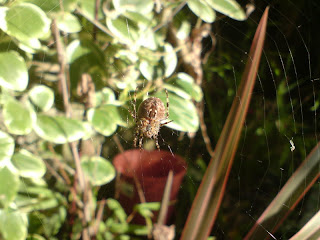Sunday, November 04, 2007
Monday, October 29, 2007
Thursday, October 18, 2007
Wednesday, October 17, 2007
Tuesday, October 16, 2007
Monday, October 15, 2007
Tuesday, October 09, 2007
Cleared the garden
I burnt all the clippings I'd heaped up in the garden and a few larger pieces of wood left over from "stuff". I used the BBQ as a fire pit and then, towards the end thought I might as well have a bbq... seeing as the embers were so hot (see below)
...and had a BBQ
On the embers of the garden rubbish I cooked 2 sausages, I also smoked a whole bulb of garlic on the embers aswell, but I also ended up half roasting it so I didn't think it would keep very long, I had a few cloves with this and that and composted the rest. Tasty!
Saturday, September 29, 2007
Prawns for Lunch
Prawns fried with 3 cloves of garlic, black pepper and then lightly covered in mayonnaise then served in romaine lettuce leaves and eaten with the hands like lettuce sandwiches... mmm.
Hardly a bad price
 Currently on half price at £3.99 this wine is rather good value. Then take into account that if you buy 6 bottles (or more) Sainsburys give you 25% off, you end up with a bottle of wine around the £3 instead of it's regular £7.99. Weighing in at 13.5% it packs a punch without being too strong; It tastes pretty good too...
Currently on half price at £3.99 this wine is rather good value. Then take into account that if you buy 6 bottles (or more) Sainsburys give you 25% off, you end up with a bottle of wine around the £3 instead of it's regular £7.99. Weighing in at 13.5% it packs a punch without being too strong; It tastes pretty good too...Thursday, September 20, 2007
Saturday, September 08, 2007
Update
The main reason i'm not updating my blog very much is because my mobile is currently broken and being repaired... as such I can't take good photos and blog them quickly.
it's been over a week now so I expect my phone back any minute...
it's been over a week now so I expect my phone back any minute...
Wednesday, September 05, 2007
New Look
I have re-vamped the image of this blog and added a counter to see if anyone reads it, as I have done almost nothing else in many months I doubt it will tick over particularly fast.
Saturday, August 25, 2007
Tuesday, August 21, 2007
Thursday, August 16, 2007
Wednesday, August 15, 2007
Saturday, August 11, 2007
Wednesday, August 08, 2007
explanation of Ladybird photos (below)
Cut back the fig tree in the garden today, it had grown across the pavement.
Saw ladybirds, apparently England is under threat from Ladybirds, it's the terrorists' secret weapon.
or rather:
Britain's best-loved beetle, the ladybird, is under threat from the world's most invasive ladybird species - the harlequin ladybird (Harmonia axyridis).
A UK-wide survey, launched on Tuesday 15 March 2005 at the Natural History Museum, is calling for gardeners, farmers and wildlife enthusiasts to record any harlequin ladybirds they find.
The survey results will reveal how widely the harlequin has spread throughout Britain and provide vital information on the potential threat to the UK's native ladybirds.
An extremely voracious predator, the harlequin ladybird easily out-competes native ladybirds for its preferred food of green fly and scale insects. When these food sources are scarce they readily prey on native ladybirds and other insects such as butterfly eggs, caterpillars and lacewing larvae.
The harlequin ladybird was introduced to North America from Asia to control plant pests and, 20 years later, has become North America's commonest ladybird. First spotted in the UK in September 2004, sightings have mainly been confined to the south east of Britain.
‘The harlequin is a deadly threat to our own British ladybirds’, commented Dr Michael Majerus, for Cambridge University. ‘We need to monitor them closely in order to assess the spread and impact of the insect.’
Dr Helen Roy from Anglia Polytechnic University, one of the partners in the project, adds ‘monitoring ladybird populations has never been so important.’
http://www.nhm.ac.uk/about-us/news/2005/march/news_3416.html
http://www.harlequin-survey.org/
Saw ladybirds, apparently England is under threat from Ladybirds, it's the terrorists' secret weapon.
or rather:
Britain's best-loved beetle, the ladybird, is under threat from the world's most invasive ladybird species - the harlequin ladybird (Harmonia axyridis).
A UK-wide survey, launched on Tuesday 15 March 2005 at the Natural History Museum, is calling for gardeners, farmers and wildlife enthusiasts to record any harlequin ladybirds they find.
The survey results will reveal how widely the harlequin has spread throughout Britain and provide vital information on the potential threat to the UK's native ladybirds.
An extremely voracious predator, the harlequin ladybird easily out-competes native ladybirds for its preferred food of green fly and scale insects. When these food sources are scarce they readily prey on native ladybirds and other insects such as butterfly eggs, caterpillars and lacewing larvae.
The harlequin ladybird was introduced to North America from Asia to control plant pests and, 20 years later, has become North America's commonest ladybird. First spotted in the UK in September 2004, sightings have mainly been confined to the south east of Britain.
‘The harlequin is a deadly threat to our own British ladybirds’, commented Dr Michael Majerus, for Cambridge University. ‘We need to monitor them closely in order to assess the spread and impact of the insect.’
Dr Helen Roy from Anglia Polytechnic University, one of the partners in the project, adds ‘monitoring ladybird populations has never been so important.’
http://www.nhm.ac.uk/about-us/news/2005/march/news_3416.html
http://www.harlequin-survey.org/
Sunday, August 05, 2007
Saturday, August 04, 2007
Friday, August 03, 2007
Wednesday, August 01, 2007
Monday, July 30, 2007
Sunday, July 29, 2007
Saturday, July 28, 2007
Friday, July 27, 2007
Thursday, July 26, 2007
Wednesday, July 25, 2007
Tuesday, July 24, 2007
Tuesday, July 10, 2007
Subscribe to:
Comments (Atom)
















































